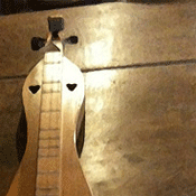Latest Activity
AllLatest Group Discussions
AllStrange Intermittent Buzzing "Wahh" noise appearing
Hi folks, I've got a strange thing going on - my latest Dulcimer is...
@tpatts 5 years ago - Comments: 15
What Thickness do you use for the Top & Bottom boards?
Hi all, I've just finished Dulcimer #3, scratch-built to my own design....
@tpatts 6 years ago - Comments: 5
Including an extra bass string
Hi everyone, I've just entered the world of 4 equidistant strings. As I...
@tpatts 6 years ago - Comments: 1
Tips for using loop end strings on a build?
Hi, I’m getting ready to start dulcimer #3 and have just purchased some...
@tpatts 6 years ago - Comments: 8
Humbucker stye pickup...?
Hi all, has anyone put a humbucker style pickup on a dulcimer? If so,...
@tpatts 6 years ago - Comments: 6
Your favourite or preferred shape to build / play
hi every one! I’m looking to build my 3rd dulcimer. my first was a 26”...
@tpatts 6 years ago - Comments: 12
Different possible tunings
Hi all, I’ve experimented with some different modes (is that right? I’m...
@tpatts 6 years ago - Comments: 5
Placement for Piezo Pickup
Hi all, I’m about to embark on my second dulcimer build - an elliptical...
@tpatts 6 years ago - Comments: 5




Hello there!
Might have an idea for you re your questions about the pins used for loop end strings. Hope I can explain this verbally...
I have always used loop end strings on my instruments. When I first started I thought I could use simply brads or escutcheon nails. After having a couple of them launch into the ceiling when applying string tension, I realized I needed something better.
I'm not sure how the UK measures or names their screws. Here in US our wood screws are sized by their gauge (with a number like 6, 8, 12, etc.) Smaller the number, the smaller the screw's shaft is. Also have options re: head shape such as flathead - FH, countersink head CS, etc. Also in the description of the screw is the length of the screw. US is inches or fractions thereof. I suspect yours are mm? Lastly is the method of driver needed to put the screw in or take it out. Slotted, Phillips, Square, Star...
Inside the body of my dulcimers I make sure I have a tail-block made of a good sound hardwood. I make sure the screws I'm using for my string pins are going to bite into this block a good bit.
I use either brass or stainless steel, #6, 3/4 inch roundhead screws. The only drawback it that their heads are a little too large to be able to get them close together. I remedy this by taking each individual screw and chuck the threads into my portable drill. Then with my disc sander running I turn on my drill and apply the turning head of the screw against the sanding disc. This will lessen the diameter of the head very quickly. Experiment with running the drill either in forward or reverse. Use caution that you don't end up with a slot that is too small for a screw driver to get a bite on. Also leave the head of the screw a little proud of the upper shaft of the screw... I aim for about a mm or a little more.
I usually buy a couple dozen screws at a time and then "dress" them prior to needing them. Then when I do need a set, they are ready.
Good Luck, John Ellis, Sunny Day Dulcimers, Everett, WA, USA
web site: sunnydaydulcimers.wix.com/john
Hi Tatts, and welcome to the wonderful world of the Friends of the Mountain Dulcimer. It's a good place to come, spend some time, learn about the dulcimer, and meet some good people.
Ben
( Liked a group discussions item created by @john-astor : Free Fingerpicking Album to download for all!)
Can you download this, I get an error. Any clues or any other way?
Welcome
m.
Welcome Tatts to Friends of the Mountain Dulcimer. Glad you joined. This is a wonderful family of friendly people who love the dulcimer and its sweet song. Best wishes on your dulcimer journey.
Welcome to FOTMD Tatts. It is good to have you aboard.
Ken
"The dulcimer sings a sweet song."
Hey Tatts, welcome aboard. Glad ya found us.